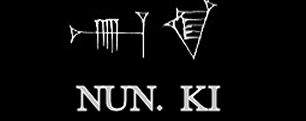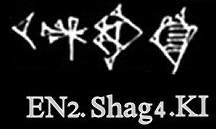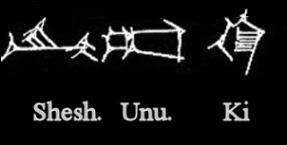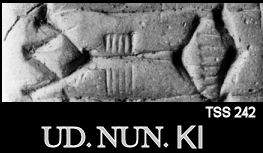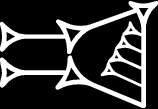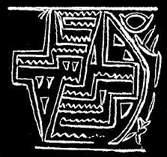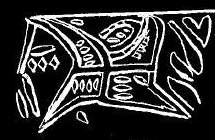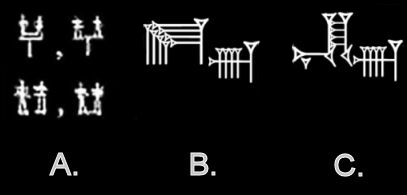Archaic City Seals and Geographic Names
|
*refer to fig.1 at the top of the page for visual*
On an archaeological dig in Jemdat Nasr 10 years after the finds at Ur, there was discovered even earlier seal impressions - these impressions are from the Uruk III period and resemble closely the City seals found in Ur; furthermore, in part because of the anitquity of this findspot, these impressions help to establish that the city devices are older then writing itself. An important understanding about these earlier impressions is that they come from the one and the same seal. So archaeologists have found numerous examples of tablets from Jemdat Nasr (and one from Urum) where the same seal has been used - this seal contains the devices of numerous cities some of which are identifiable. Despite the lack of diversity in the extent examples from this period, an advantage is that these impressions, unlike in the instances in Ur, these earlier examples are stamped on tablets which also contain cuneiform writing: this allows some additional context for interpreting their use and significance. For this we refer to P. Steinkeller beflow (see e: Political Signicance and Leagues). Tablets bearing the Uruk Seal Impression:
About Geographical Names (Adopted from D. Katz 2003 (2)): *refer to fig.2 at the top of the page for visual* The term "Geographical name" refers to a formulae or convention in the way cuneiform texts name cities. This formulae characterizes the way that the names of important religious centres were written in the earliest texts, and indeed in subsequent cuneiform literature as well. The formula of a geographical name is actually very simple, and is this: DN+UNU. This stands for divine name + UNU. Lets ask, what is the UNU sign? The Pennsylvannia Sumerian Dictionary entry for the sign UNU gives the following possible meanings for this sign: "banquet; dining hall; the most sacred part of a temple; seat, throne; dwelling, domicile, abode; temple". Essentially, the sign in combination with the divine name (DN+UNU) indicates the city in question by referring to the inner sanctum, the dwelling place, of that cities chief deity. What is interesting to note is that these geographical names,
for example UD+UNU (Larsa), or SHESH+UNU (Ur), seem to be direct
adaptions of the
Early protoliterate City Seals. This becomes clearer still when
we note that the cuneiform sign UNU, a part of the geographical
names, (when flipped
vertical) appears to be a direct adaption from the 'base' or
'stand' in the seals. It symbolises the abode of the deity,
so UD+UNU is the home of the Sun god, and the UNU is a part
of his temple.
3 examples for Edinnu Among the seals impressions from Ur ar numerous seals depicting
the edinnu, the fertile plain. Given the
importance of irragation and canal systems for agriculture and
life in Mesopotamia, it is interesting to see those times that
the edinnu is depicted in the
seals - Legrain describes: 'essentially these depictions consist
of a field enclosed right and left by semicircular lines divided
by vertical and zigzag
lines into compartments...All free space within is filled with
dentils- the gunu system of the scribes- which means
solid ground.'(3) In addition
some depictions of the edinnu contain wavy lines which we seem
easily enough to suggest the fresh water of the canals with
watered the field - it's
interesting to note the same wavy lines at the bottom of the
City Seal devices (at the very base of the UNU), and that the
edinnu sometimes features along
side the City Seals. Comments on the Eridu and Adab seals: While the larger portion of City Seals seem to follow the DN+UNU
structure, there are exceptions. Eridu for example, is represented
by what is termed "the great pole", and the Adab seal
features the same but with the addition of a rising sun. Unfortunately, little can be said about the great pole and crossbars, beyond the device is called NUN.
Detail of the Kesh seal: We should recall that Kesh was an archaic city which remains undiscovered; it is known however from the Kesh Temple hymn, and we know it to be the city of Ninhursaga (sometimes, a birth goddess.) Piotr Steinkeller [5] submited an interesting discussion on the seals which we review further below, but for now, note 27 from that same paper is interesting for its detailed comments on the Kesh Seal:
"27. This toponym was interpreted by M. Lambert, RA 64 (1970): 189, as either Umma or Akshak. Identification with Kesh was suggested by Green, ASJ 8 (1986); 77. Matthews, MSVO 2, 34-35, analyzes the grapheme in question as "two signs, perhaps the jar with lid." The "jar" is more likely a "womb," related formally to the "omega" symbol of Ninhursag = uterus with ovaries, for which see J. Black and A. Green, Gods, demons and Symbols of Ancient Mesopotamia (Austin, 1992), 146-47. The second sign is probably ŠU2 (= ZATU-534). This writing is conceivably a precusor of KEŠ3, which unquestionably appears on several Ur sealings.."
(it appears on the Ur seals..) "either in its complete
form EN2(=ŠU2+AN)).ŠAG4 .. or defectively as AN.ŠAG4..
A possible meaning of the latter logogram is
en2 "incantation" (Akk. šiptu) + ŠAG4 "womb"
i.e. "the one of womb/birth incantations," referring
to Ninmah/Ninhursag, the goddess of Kesh..."
In sum, Steinkeller says that the Kesh seal from the Uruk III
period is likely the precursor to that we see in Ur in the ED
period, and that, in the later occurrence of the seal especially,
a reading of EN2 + ŠAG4 is possible - how is it he says
that this should be read with EN2? If we remember what the word
This first part of this is EN2 - the wedge and the AN sign (like a star). Now if you turn this vertically, doesn't it look just like the top part of the Kesh city seal from Ur? Therefore, some experts, after identifying the below parts as ŠAG4, are able to say incantation-womb, and associate Ninhursaga who is said to know the birth incantations, and whose city was Kesh.
&;quot;As is so often the case in matters early Mesopotamian, it is to Jacobsen that we owe the first cogent argument for the existence, in the late prehistoric through the Early dynastic periods, of a supra city-state institution that united all Sumer into a single political and religious body. According to Jacobsen, this hypothetical institution - dubbed by him the "Kengir League" - was centered around the city of Nippur, which served as the league's meeting place, as well as the religious capital of all Sumer." Part of the evidence adduced by Jacobsen in support of his proposal was a group of "puzzling jar sealings" from archaic Ur, which bear multiple depictions of city names. [note: the city seals from Legrain 1933.] As Jacobsen reasoned, "since such collective sealings imply collective responsibility for the goods sent under the seal we may see in them evidence of official deliveries to Ur by groups of cities, a feature most easily understandable in terms of a league of cities such as the Kengir League. An obvious parallel is the bala deliveries of later times." The author adds that ten years after Jacobsen had made these
claims another "collective city seal" was found in
Jemdat Nasr. In addition a tablet bearing the same seal has
been found from outside Jemdat Nasr. By "collective city
seal" it is meant one seal that depicts the names of numerous
cities - this collective seal appears on numerous tablets dating
to the Uruk III period. Scholars it seems, have largely continued
with Jacobsen's original proposals about the Ur seals, and see
them as evidence of a cooperative institutionalized grouping
for the most part. Steinkeller's first step is to exclude Legrain's Ur City Seals from direct consideration "since they only survive on jar sealings, which is not enough to determine the nature of the administrative context in which they functions." However, he see's the early Uruk III seal differently (pictured above) because "it is impressed on inscribed tablets, whose contents might potentially elucidate the background of the respective traditions." Turning to the Uruk III seal which depicts numerous city names or "toponyms", this same seal is found on numerous tablets from Jemdat Nasr, and Steinkeller is keen to point out, that same seal is on another tablet which turns out to be from ancient Urum (not to be confused with Urim = Ur.) The author uses his insight on toponyms, city names, to reassert that MSVO 4, 15 DOES in fact come from Urum (which had be overlooked elsewhere) and proceeds with his idea to re examine the text on that tablet and the others and to attempt to contextualize the seals also present. He notes that both the tablets from Jemdat Nasr that have the seal, and the one from Urum, both inscribe lists of the same products: figs, apples, wine (or grape/raisins), and a certain fish product. Whats more, the final column of the tablets being compared contain notations which are basically parallel. In Jemdat Nasr these read: NI.RU Inanna/Dingir 3 Unug In the Urum text it reads: Ur2. ?A."RAD" MAHxNA dingir 3 PAP Unug Steinkeller offers a new interpretation of these notations, and suggests for Inanna/dingir 3 Unug, a translation of "triple Inanna/deity of Uruk." This he says is representative of the three forms of Inanna to whom offerings were regularly made in archaic Uruk: Inanna ?úd(UD), "morning Inanna," Inanna s i g, "evening Inanna," and Inanna NUN, "princely Inanna." His interpretation as given for these lines is this then: (Jemdat Nasr) (Urum)
the city seal
[meaning, the one who took the goods left HIS seal on the list-tablet , which acted as proof, as receipt, that the exchange took place.] "Such receipts would be deposited among the records of the issuing party, to serve as proofs of expenditures." [the one to make the offerings to Uruk keep the list-tablet, along with the collectors seal - like a signature - as proof of their offering] "Such records would be deposited among the records of the issuing party, to serve as proofs of expenditures. If, as seems highly likely, the documents considered here are receipts as well, we would have to assume that the city seal identified the recipient of the foodstuffs destined as offerings for Inanna of Uruk. In other words, that person or persons acted as an official collector of such offerings. Since the seal is impressed on tablets both from [Jemdat Nasr and Urum], this necessarily means that [the seals] "owner" was based outside of either of these two cities, and that he represented therefore, some supra city-state institution.. As the facts can best be reconstructed, a representative of that institution traveled to [Jemdat Nasr] and Urum, collected the offerings for Inanna, and left behind receipts sealed with his official seal."
"With all due caution, it may be suggested that the"organization" thus reconstructed was an antecedent of the later "Kengir League." Although that amphictyonic organization remains a largely hypothetical construct, it would seem likely that, as indicated by the Ur III data pertaining to the so-called bala institution, its focus was the city of Nippur and its chief deity Enlil. This leads us to the unavoidable conclusion that, sometime in the beginning of the Early Dynastic period, the original Urukian organization underwent a dramatic transformation, by which its focal point was transferred from Uruk to Nippur. Such a development appears to be entirely plausible, for there exists independent evidence of the rise, roughly at that time, of Enlil to the position of the head of the Sumerian pantheon, which was concomitant with the decline of the importance of the cults of Enki and Inanna. Undoubtedly, this religious transformation reflected political changes which had taken place either at the end of the Uruk period or at the very beginning of the Early Dynastic times: the ascendance of the city of Kish and its region to power, as a result of which the center of gravity of Babylonian politics had moved from the area of Uruk and Eridu to the region of Nippur This brings us, finally, to the issue of the city sealings from Ur, which provided some of the inspiration for Jacobsen's "Kengir League." In light of what we now know about the Uruk III seal, it will not be unreasonable to assume that these sealings attest to a similar arr`angement of amphictyonic nature. But around which particular city and cult did this arrangement center? The fact that the sealings seem to date to the ED I period should probably favor the choice of Nippur, since it is likely that, already then, Nippur enjoyed the status of religious capital of Babylonia. But without any corroborating evidence, this whole question must remain open for now." Further Questions: |
